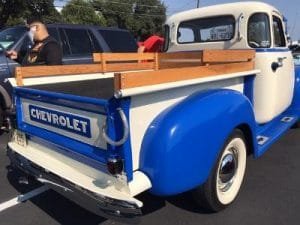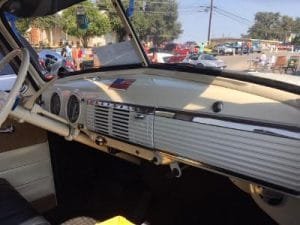Featured is a great looking restored 1951 Chevrolet 3100 Half Ton. Part of the new Advance Design Chevrolet’s which debuted in 1947. Advance Design light trucks used numeral identifiers. The 3100’s were half tons, 3/4-tons were designated 3600, and one ton trucks 3800.

The Advance Design which spanned the 1947 through 1955 model years ushered in many major changes and upgrades to Chevy light trucks.
Advance Design Chevrolet trucks were produced with comfort and style in mind. They added much more comfort for driver and rider than previous designs and were built to be rugged and durable which is why so many have lasted all these years. It’s said that these new Chevy light trucks represented the beginning of designs that would put the same amount of effort into styling as was put into cargo carrying.
The new Advance Design cab was wider and offered more head and leg room.Regarding the popularity of Chevy’s Advance Design, the Chevy Division was the number one truck manufacturer during all of the Advanced Design years. That says a lot.
1951 Chevy 3100 Styling
The 1951 Chevy Half Ton included all of these Advance Design changes…The letters on the tailgate were not painted but rather they were the same color as the tailgate…..The bed planks/boards were southern yellow-pine, painted black, and were not varnished. It was said that the boards were “stained” with coal tar oil and then finished with linseed oil…Half ton pickups prior to 1955 used 16″ wheels…In dash radios were an option…Chrome grille and bumpers were an option. .The deluxe cab had optional Nu-Vue windows which had chrome trim…Vent windows in the cabs.The vent windows were not seen in the 1947-1950 models.Trucks built in 1951 and later did have them. The 1951 Chevy 3100 was also the last model built with an 80 MPH speedometer.
In regards to windows and better visibility, Chevrolet offered a wider windshield area along with, as an option, larger corner panel windows which helped to help reduce blind spots. If you had a Chevy 3100 Deluxe those corner windows were standard. As a side note, the Chevrolet Advance Design trucks had a split windshield from 1947 through the 1953 model years. Beginning with the 1954 model, the windshield was a single piece and slightly curved.
1951 Chevy 3100 Specifications

The carburetor had an improved fast-idle/choke mechanism that helped cold weather starts. All of this continued until 1955 when Chevrolet put in their new V-8’s.
Transmission was a three speed manual on the column.
Brakes were four wheel hydraulic drums.
 Dimensions include a 116 inch wheelbase with an overall outside length of 196.6 inches. The cargo bed was 78 inches long and 50 inches wide.
Dimensions include a 116 inch wheelbase with an overall outside length of 196.6 inches. The cargo bed was 78 inches long and 50 inches wide.
Curb weight was 3,300 lbs. The price new in 1951 was about $1,450.
See related Auto Museum Online articles found on the links below..
Reference material for this article includes…Chevrolet Pickups by author Mike Mueller. The book tells the story about how Chevy Trucks evolved over the years…GM HertitageCenter.com…Standard Catalog of American Light Duty Trucks by author John A. Gunnell.
1951 Chevy 3100 Collector Popularity
 At the current time Chevy Advance design light trucks are very popular with collectors. Values for many of these models appear to be at all time highs. At this time Chevy Pickups from the 1940’s through the 60’s and into the 70’s are the hot ticket.
At the current time Chevy Advance design light trucks are very popular with collectors. Values for many of these models appear to be at all time highs. At this time Chevy Pickups from the 1940’s through the 60’s and into the 70’s are the hot ticket.
These Chevy trucks were built to last and they were styled very different from prewar trucks. A good number have moved from the farms to the hands of collectors.
Current collector car values for restored models in excellent condition are in a range of from about $35,000 to $50,000. plus.We have also seen some models with $80,000 and above asking prices. These are about double what the prices were 10 years ago.
Protect your truck with this EzyShade 10-Layer Truck Cover Waterproof and All Weather. Full outdoor pickup truck covers. See the vehicle size chart on the link below…
Auto Museum Online searches for various products that we feel the classic car and automobile community in general can benefit from. As an Amazon Affiliate, Auto Museum Online earn a commission from qualifying purchases through my links, at no cost to you.
(Article and photos copyright Auto Museum Online)
